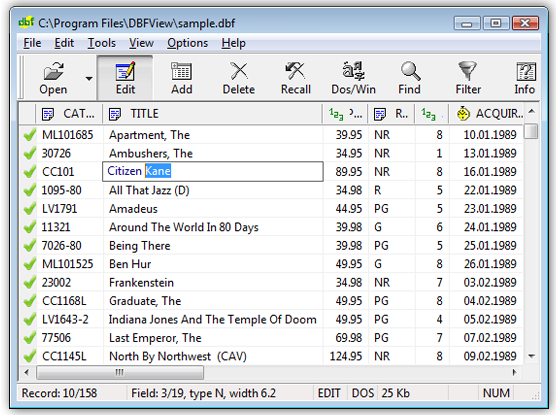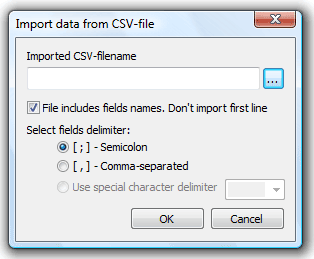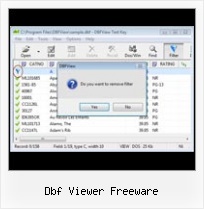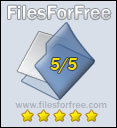DBF File Viewer

DBF Converter & DBF Viewer - the most popular
DBF editor and viewer for
Windows 9x/NT/2000/XP/Vista/Win7!
View dbf file, edit dbf file, and print dbf files!
DBF Converter & DBF File Viewer is a compact but powerful tool for viewing, editing, and printing DBF-format databases. DBF Converter & DBF Viewer uses its own database access tools and does not require external drivers for connection to databases (such as ODBC or BDE) or additional libraries (.OCX, .DLL). The program allows you to add, delete, recall, sort, zap, pack records, view and edit files in DOS or Windows character sets, get detailed database information, export to txt/html/csv/xls/xlsx format, and search in a file.
Overview
DBF Converter & DBF Viewer is a compact but powerful tool for viewing, editing, and printing DBF-format databases - screen shot.
It supports dBase, Clipper, FoxPro, Visual FoxPro and other DBF file formats. In contrast to many analogues, DBF Converter & DBF Viewer is completely a Windows 9x/NT/2000/XP/Vista program. The user friendly graphic makes working with databases simple and hassle free.
Most important parts of DBF Converter & DBF Viewer code are written in Assembler, therefore the basic operations performs fast and the .exe file is very small (only 410Kb!).
DBF Converter & DBF Viewer uses its own database access tools and does not require external drivers for connection to databases (such as ODBC or BDE) or additional libraries (.OCX, .DLL).
The program allows you to add, delete, recall, sort, zap, pack records, view and edit files in DOS or Windows character sets, get detailed database information,export dbf files to txt/html format, convert csv and xls / xlsx to dbf format, import/export from MS Excel (including MS Excel 2007!), and search in a file. DBF Converter & DBF Viewer comes with Installer/Uninstaller, documentation in HTML format, and sample files.
How to Use
Csv to Dbf Import
Import from CSV to DBF
Imports data from csv comma-separated text file into current dbf database. You can select delimiters/separators as well as include a first line from the csv file.

Order DBF Converter & DBF Viewer for Windows
Ordering online is easy and secure. You can select the most suitable payment method: credit card, bank transfer, check, PayPal etc.. Paying a registration fee, you get the right to use the program for life and to get free updates within one year.
jednoduchy prevod xls do dbfPostal Address
For feature requests, troubleshooting, general help contact Customer Support at  . Make sure to include details on your DBFView version, browser, operating system and a link (or relevant code).file xls to dbf
. Make sure to include details on your DBFView version, browser, operating system and a link (or relevant code).file xls to dbf
Feedback
Helen Mitten - Software Manager
We were interested because our users needed something quick and easy to view dbf files and we did not want to use FoxPro. We had another utility that works on Windows 95 and NT but would not work on Windows 98. We tried using Excel but it would only read up to 65,536 records and some of the files they look at are larger than that. I had looked at another dbfviewer but it did not have all the functionality that yours has.
Mike Koch - System Administrator
I found DBFView after a lengthy search on the net. I was looking for an interface that could provide a view, update, and edit interface for a large database that could reside on an internet drive (like X-Drive), where I and co-workers out of state could access and quickly update our numbers (basically job/data tracking for telecommuters). The company does photo-editing (school, corporate, restorative work) utilizing high-speed internet, waveform compression, and some good computer artists. Maybe 5000 negative scans per year.
Anyway, nobody wanted to install full-blown database programs, sql server or the like, the company is not that big, nor is the data itself considered critical. So for this type of user, your interface provides clean, quick, simple, no syntax required, put the data in and go. Others I looked at tried to do the same but usually forget the "people element", and I don't have time to learn sql syntax and help them complete their programs. (Incidently, I used to have a lot of fun programming DBase II and III, then I saw Access and cried).
Byron Pate - Software Developer
First off I would like to tell you what a great product DBFView is. I'm trying to convert a large dbase file into SQL Server and the dbf file is giving me a great deal of problems, and DBFView has allowed me to go in and find the records with problems and fix them.
Screenshot
Awards
Blog
Nice Web Development Applications
Nice Free Website Design Builder Software - Review
Awesome Cheapest Web Page Builder | Beginner-Friendly Tutorial
Nice Mobile Site Builder | Easy Guide
Smart Mobile Web Builder | In-Depth Review
More
Convert DBF to Excel 2007
Convert DBF to XLS
Edit DBF File
Convert XLS to DBF
Open DBF File
Convert DBF to CSV
Export DBF to Excel
Import XLSX files to DBF
Export Dbase To Excel
Delete Files From Dbf
File Convert From Xls To Dbf
Convert Csv Ke Dbf
Dbf Archives Programs
Da Excel 2007 A Dbf
Dbf In Excel Importieren
Change Xls To Dbf
Convertir Csv Dbf
Dbf Pack Setup Exe
Free Foxpro Dbf Export To Xls
Exportar Dbf
Converting Dbf Files To Xls
Converting Dbf To Csv









